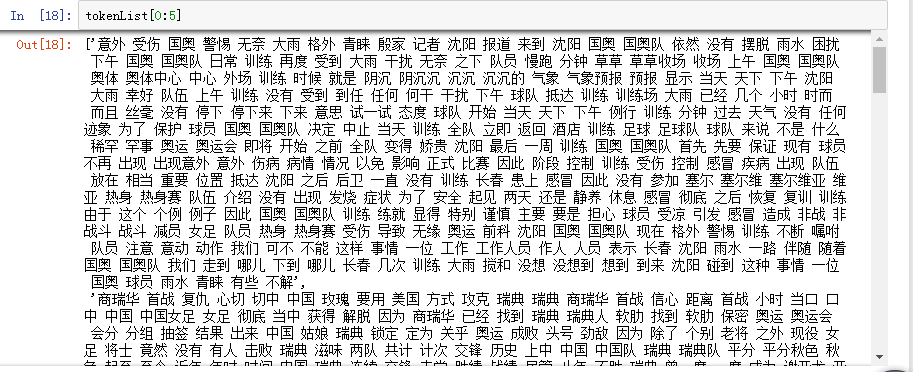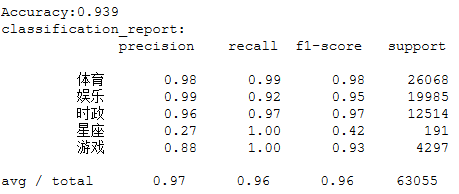期末大作业
一、boston房价预测
1. 读取数据集
# 多元线性回归模型 from sklearn.datasets import load_boston from sklearn.model_selection import train_test_split
2. 训练集与测试集划分
# 多元线性回归模型 data = load_boston() x_train,x_test,y_train,y_test = train_test_split(data.data,data.target,test_size=0.3)# 划分数据集 print(x_train.shape,y_train.shape)

3. 线性回归模型:建立13个变量与房价之间的预测模型,并检测模型好坏。
# 建立多元线性回归模型 from sklearn.linear_model import LinearRegression LineR = LinearRegression() LineR.fit(x_train,y_train) print('系数',LineR.coef_,'\n截距',LineR.intercept_)

4. 多项式回归模型:建立13个变量与房价之间的预测模型,并检测模型好坏。
# 检测模型好坏 from sklearn.metrics import regression y_predict = LineR.predict(x_test) # 计算模型的预测指标 print("预测的均方误差:",regression.mean_squared_error(y_test,y_predict)) print("预测的平均绝对误差:",regression.mean_absolute_error(y_test,y_predict)) # 打印模型的分数 print("模型的分数:",LineR.score(x_test,y_test))

5. 比较线性模型与非线性模型的性能,并说明原因。
非线性模型的模型性能较好,因为它是有很多点连接而成的曲线,对样本的拟合程度较高,而且多项式模型是一条平滑的曲线,更贴合样本点的分布,预测效果误差较小。
二、中文文本分类
分别建立中文文本分类模型,实现对文本的分类。基本步骤如下:
import os import sys import numpy as np from datetime import datetime path = 'E:\\0369' # 导入结巴库,并将需要用到的词库加进字典 import jieba with open(r'E:\\stopsCN.txt',encoding='utf-8') as f:# 导入停用词 stopwords = f.read().split('\n')
def processing(tokens): tokens = "".join([char for char in tokens if char.isalpha()])#去掉非字母汉字的字符 tokens = [token for token in jieba.cut(tokens,cut_all=True) if len(token) >=2]#结巴分词 tokens = " ".join([token for token in tokens if token not in stopwords])#去掉停用词 return tokens tokenList = [] #生成空的文本列表 targetList = [] #类别列表 #用os.walk获取需要的变量,并拼接文件路径再打开每一个文件
#root是当前正在遍历的这个文件夹的本身地址,dirs,files是一个list,
dirs内容是该文件夹中所有的目录的名字,files内容是该文件夹中所有的文件
for root,dirs,files in os.walk(path):
for f in files: filePath = os.path.join(root,f) with open(filePath,encoding='utf-8') as f: content = f.read()
target = filePath.split('\\')[-2]#分割后的倒数第2个元素#获取新闻类别标签,并处理该新闻 targetList.append(target)#把各类别追加到干净的tarList = []列表 tokenList.append(processing(content)) #把预处理过后的文本追加到干净的txtList = []列表

#划分训练集测试集并建立特征向量,为建立模型做准备 from sklearn.feature_extraction.text import TfidfVectorizer from sklearn.model_selection import train_test_split from sklearn.naive_bayes import GaussianNB,MultinomialNB from sklearn.model_selection import cross_val_score from sklearn.metrics import classification_report x_train,x_test,y_train,y_test = train_test_split(tokenList,targetList,test_size=0.2,stratify=targetList)#划分训练集测试集 #转化为特征向量,这里选择TfidfVectorizer的方式建立特征向量。不同新闻的词语使用会有较大不同。 vectorizer = TfidfVectorizer() X_train = vectorizer.fit_transform(x_train)#对部分x训练集数据先拟合 X_test = vectorizer.transform(x_test)#对X测试集进行转化
mnb = MultinomialNB() module = mnb.fit(X_train,y_train)#拟合x,y训练集数据 #进行预测 y_predict = module.predict(X_test) scores = cross_val_score(mnb,X_test,y_test,cv=5) print("Accuracy:%.3f"%scores.mean())#输出模型精确度 print("classification_report:\n",classification_report(y_predict,y_test))#输出模型评估报告

#将预测结果和实际结果进行对比 import collections import matplotlib.pyplot as plt from pylab import mpl mpl.rcParams['font.sans-serif'] = ['FangSong'] #指定默认字体 mpl.rcParams['axes.unicode_minus'] = False #解决保存图像是负号'-'显示为方块的问题 #统计测试集和预测集的各类新闻个数 testCount = collections.Counter(y_test) predCount = collections.Counter(y_predict) print('实际:',testCount,'\n', '预测', predCount) #建立标签列表,实际结果列表,预测结果列表, nameList = list(testCount.keys()) #各类别名称 testList = list(testCount.values()) #实际结果列表 predictList = list(predCount.values()) #预测结果长度 x = list(range(len(nameList))) #类别长度 print("新闻类别:",nameList,'\n',"实际:",testList,'\n',"预测:",predictList)




